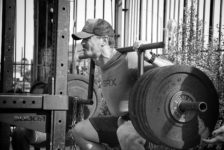
Rep ranges may be one of the most misunderstood staples in the fitness arena. They are they for a specific purpose to drive a specific adaptation. Everyone in the gym is performing reps and they are actively picking weights to use. I don’t think it’s too much of a stretch to assume that they have goals they are chasing seeing as they are in a gym making themselves uncomfortable. Maybe I am way off, who knows? But, at least for those that seem to be confused, here are some nuggets that might help steer you to where you are going.
Low Rep Range: 1-5
The driving force behind lifting weights in this category is the development of strength and the neurological adaptation that comes along with. Contrary to some misconceptions the goal here is not size. Increasing the capacity of your brain to flip all of the switches (aka recruit more muscle fibers) in order to move such a load takes some time with the heavy ones, but this is a welcome benefit of staying in the heavy category. These weights are very taxing on the CNS and take some time to recover from. Your body can do amazing things, but it needs time to reboot. When speaking in terms of 1RM these weights are 85%+. These are truly thinking weights. They are way to heavy to lackadaisically walk up to a bar and try to execute. Get your head in the game, then get it done. Strength is the game here, size (aka muscle growth) may show up a bit. When speaking about a set of three, for example, the load on the bar should be heavy enough that five reps is not possible, the third rep is all that you can complete maintaining proper mechanics. The movements you see in this category are the large compound movements such as squat, deadlift, bench press, and the olympic lifts.
Medium Rep Range: 6-12
Here we are looking for something called hypertrophy. What I mean is muscle growth in terms of size. We are trying to increase the cross sectional area of the muscles. This is where the bodybuilder resides. These sets make muscles get larger. It is possible to build strength in the lower end of this scale, but the weights demanded by the reps just don’t get the same response from your body than the heavier ones. There is still some neurological adaptation taking place here, as well. The percentages lay in the 70-85% of 1RM category. An ideal set of eight reps should be difficult to maintain form and complete reps six through eight. If you pick a weight that eight reps is easy with, you are mistakenly not stressing the tissues, and will not receive the benefit of this rep range nearly as much as you could with an increased weight. These movements can be simpler single joint movements as well as the compound multipoint movements in the heavier rep ranges.
High Rep Ranges: 13-20+
Muscles endurance is the focus here. Hypertrophy (muscle growth) is lessened and strength development is also diminished. The benefit of such high reps is increased blood flow (aka the ‘pump”) to the muscles which helps in the recovery and the building of tendons and ligaments. Typically these movements are going to be smaller more focused muscles groups, example tricep extensions and hamstring curls.
In any of these ranges just remember, your body changes when you stress the tissues. If you do a set of two or eight or fifteen reps and you don’t stress the tissues, you are missing the point. These rep ranges are there for a reason. They are not just random speculation, they are based on science and lots of research. A typical day would consist of a warm up, then build to heavy reps in the low rep range. After this an athlete would spend some time in the medium rep range with one to four exercises, and then finish off the day in the high rep ranges. The big loads require your body to be fresh, so they need to be at the beginning of the session. They also recruit all types of muscle fibers, which is hugely beneficial. As your ability to move maximal load lessens, the weights on the bar will start coming off and the rep counts will go up.
Happy lifting.
Danny Lesslie
@dannylesslie
5/19/17 WOD
Make 3 attempts of the following:
Max L-Sit Hold
Then, complete 3 rounds for time of:
10 Unbroken Chest-to-Bar Pull Ups
15 Unbroken DB Shoulder-to-Overhead (50/30)
200′ Unbroken Sandbag Carry (AHAP)

